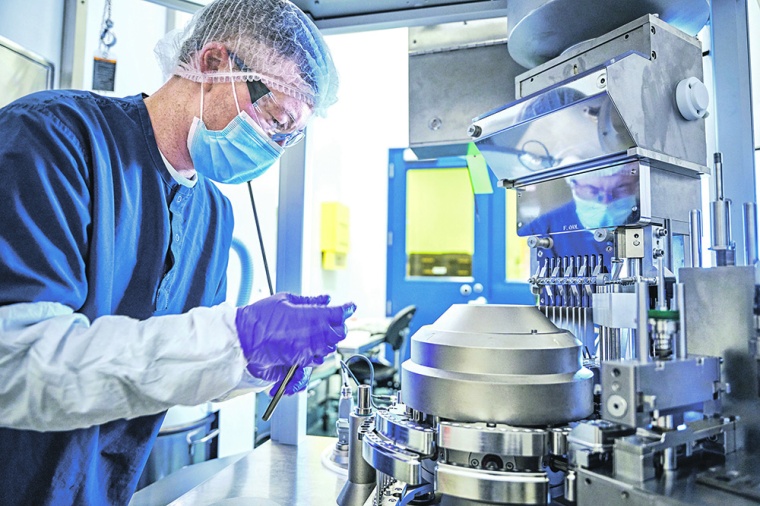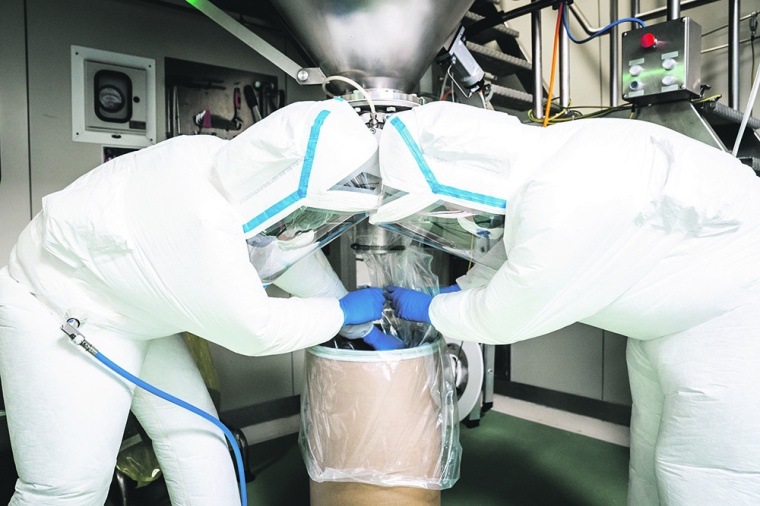Integrated Drug Development Models
Interview with Giovanna Libralon, Senior Director Commercial Development Small Molecules at Lonza.

Several convergent trends increasingly define the small molecule landscape. A growing proportion of the drug development pipeline is made up of more complex, highly potent APIs (HPAPI). These molecules are commonly associated with innovative cancer treatments, such as antibody-drug conjugates (ADC), but they also have shown effectiveness in treating autoimmune diseases, diabetes and a range of other indications. Alongside the growth in HPAPI molecules, emerging companies are increasingly driving the development of innovative molecules and products. For many companies, particularly small, emerging and even virtual biopharma companies which lack extensive in-house manufacturing capabilities, the path forward typically includes working with an external partner such as a contract development & manufacturing organization (CDMO). CHEManager asked Giovanna Libralon, Senior Director Commercial Development Small Molecules at Lonza, to share her view on the various forces impacting the industry, and how a single CDMO partner with an integrated development model can provide streamlined services, improve technical transfer, reduce timelines, and increase financial gains.
CHEManager: Mrs. Libralon, what do you see as the current market trends in small molecule and HPAPI manufacturing?
Giovanna Libralon: Highly potent APIs (HPAPIs) have a wide range of potential uses and benefits of patients, particularly for oncology and immunotherapy applications. Due to its wide set of applications, the growth of the HPAPI market is outpacing the overall API market by almost two-to-one at about 10% CAGR, compared to 6% for the overall small molecule market.
In parallel, antibody drug conjugates (ADCs), a technology for HPAPI-based cancer therapies, are expected to attract even more attention in the next five years at 26% CAGR as of 2022. ADCs allow for targeted HPAPI payload delivery specifically to cancer cells and are designed to minimize interference with healthy tissue, leading to reduced adverse toxicities — a huge challenge in cancer treatment. As a result, there has been a significant increase in research on ADCs over the last 15 years, which is a key driver for the positive HPAPI market outlook.
Another factor contributing to growth is the acceleration to market. More than 70% of small molecules new molecular entities (NMEs) have a special designation or expedited regulatory pathway with the need for rapid development and commercialization.
This is particularly challenging for emerging companies that are driving innovation. Smaller companies, which hold two-thirds of the early-stage pipeline, are increasingly filing their molecules rather than selling these assets to big pharma during clinical development since they are receiving increased funding from investments firms. Funding for biotechnology companies reached record levels in 2020, and this increased access to funds is believed to be one of the drivers for small and emerging companies to take products all the way to launch. The tendency to develop therapies for niche indications with small patient populations — about 67% of FDA approvals in 2020 — is undoubtedly a factor here as well. This has led to smaller firms owning a majority of FDA approvals at 62%, roughly doubling since 2021.

Considering those trends, what commercial and supply chain challenges do pharma companies face?
G. Libralon: The rising demand for HPAPI-based therapies is creating the need to continuously invest on HPAPI capacity and capabilities to support customers from the early stages through commercialization.
Moreover, considering that more than 70% of NMEs get accelerated approvals, the ability to identify and solve challenges earlier in development with agility and flexibility is key to allowing successful product launch. CDMOs that are able to offer integrated solutions, that is drug substance and drug products, enable rapid development and accelerated timeline. Smaller companies, that bring a majority of these innovative complex molecules to the drug development pipeline, are typically lean and rely on external service providers as their focus is on the science and the innovation of their compounds. This allows for the companies to be very nimble and agile, and as a result innovative. However, this means smaller companies face the challenge of managing multiple partners at a time, which could lead to longer timelines and by extension higher costs. This is where collaborating with a CDMO with integrated services may be strategic to ensure that processes are as streamlined as possible.
Another challenge is that more than 70% of these new small molecules entering the pipeline have poor bioavailability. This is a challenge that must be addressed early in the drug development phase to allow for a successful path to the clinic. This can involve enabling technologies such as amorphous solid dispersions, micronization, and other particle engineering methodologies.
The development of high-quality pharmaceutical products is not only demanding from a manufacturing viewpoint, but also a regulatory challenge. How can CMOs/CDMOs support the pharma sector in achieving this goal?
G. Libralon: In light of the aforementioned challenge, developing a product via an accelerated program can create additional regulatory challenges, particularly for emerging companies. Many small and mid-sized biotech companies do not have the capacity or the regulatory affairs experience needed to develop an appropriate regulatory strategy. All too often, this can cause delays throughout the development process. Involving a CDMO partner with an extensive development and manufacturing network and subject matter experts (SMEs) to advise in early development discussions may help structure a program that meets the expectations of regulators, helping secure approvals at each phase.
Some of the biggest regulatory challenges when developing drug products are the varying national requirements as well as its different interpretations. While the Food and Drug Administration (FDA) and the European Medicines Agency (EMA) application and inspection expectations are aligned based on the international harmonization guidelines, they may not always be fully identical. There may even be different expectations from regulatory bodies of other countries which are outside of the harmonization initiative. An experienced CMO or CDMO is invaluable in navigating the differences of both regulatory agencies and their input and insights have the potential to reduce cost and time in the long run.
How does a pharma company benefit from having a partner with an integrated development model? How does this strategy help with the manufacturing process, especially with the accelerated HPAPI timelines?
G. Libralon: A single CDMO partner with an integrated development model can provide streamlined services, improve technical transfer, reduce timelines, and increase financial gains. A 2017 study by Tufts University found that a single-source outsourcing model shortens the drug development cycle by up to 14 weeks while increasing financial gains by up to $45 million. This data suggests outsourcing to a CDMO where all activities are managed by one system may give emerging companies a critical leg up that would put them ahead of competitors.
For example, pharma companies conventionally work with several CDMOs for different stages of their development process; as well as different CDMOs for drug substance and drug product. However, different CDMO partners will each sample, test, and release the product before going forward — creating duplicative activities that continue to consume time and resources.
The challenge is that workstreams are difficult to isolate and often cross between different stages of the process. This includes packaging requirements, quality control and quality assurance, and liability questions. For example, manufacturing ADCs requires small molecule expertise for the HPAPI payloads and linkers, but also large molecule capabilities for the antibody. Having multiple partners to produce your ADCs’ biologics and chemical components may unnecessarily elongate timelines as they will be in separate locations.
Working with a partner like Lonza who can provide integrated services means that they have a bird’s eye view of the processes and thus reduce complexity, effort, time, and costs. Integrated models are especially useful under accelerated timelines, where time and budget are of the essence. Collaborating with a CDMO who has capabilities to deliver your small molecule product from proof of concept to commercialization on top of navigating complex regulatory frameworks can make a huge difference. Specifically, it can significantly help ease technical transfer and reduce shipping costs and time.

In which areas does the use of (new) digital technologies play a particularly important role?
G. Libralon: Digital technologies play an important role in the pharmaceutical development continuum. Software developers have made significant strides in service to drug substance process research and development scientists, especially at the critical juncture between discovery and clinic. For example, R&D information technology providers have commercialized rules-based and machine learning-enabled predictive retrosynthesis software suites to support chemists in the development and prioritization of commercially viable strategies for complex API production. New digital technology is also impacting the ways in which we conduct process optimization. Self-optimization algorithms, applied to networked and PAT-integrated microreactors, are changing the pace and cost associated with DOEs can be successfully concluded.
This is invaluable, given the backdrop of rising API complexity in modern APIs — and the associated number of steps subject to optimization studies. These are two technology areas where our Small Molecules Global R&D organization is actively working — adapting both with Lonza expertise and proprietary data, to pass the benefits to our clients.
In February, Lonza has completed an expansion at its site in Nansha, China, extending developing and manufacturing capabilities and capacity for highly potent APIs. What is the strategic purpose behind an HPAPI manufacturing site in China?
G. Libralon: Our site at Nansha, China, is an integral piece of our global drug substance and drug product design, development and manufacturing network. The main advantage of our presence in Nansha is that it allows us to leverage world-class, high-quality and reliable local suppliers of raw materials to help further increase the speed of problem-solving and manufacturing within our global network. The Nansha site also allows us to have a close pulse on the regulations in China which helps us support our global customers produce commercial products for the Chinese market or support the production of clinical materials for trials in China.
The expansion of our Nansha site demonstrates our commitment to ensuring integrated manufacturing services from early- and late-stage development to commercial manufacturing and serve our global partners. With solutions from early- to mid- to late-phases of development, these new labs strengthen our global manufacturing network. Specifically, we’re committed to supporting small and emerging companies who are bringing the majority of these innovative HPAPIs into the pipeline. A recent example is the partnership with Vivesto, a Sweden-based biotech, to manufacture their ovarian cancer drug candidate at our Nansha site.
The impacts of pandemics —as demonstrated by the disruption of global supply chains due to Covid -19 — as well as national policies and trade-related developments will likely require many Western CMOs/CDMOs to shift at least some production back to Europe and the US. Could this industry sector be beneficiary of restructured supply chains?
G. Libralon: One trend we’ve observed at Lonza is the increased demand for API production in Europe and the US. However, if we consider that most raw pharmaceutical materials are manufactured in China — on top of the growing early phase pipeline developed by Chinese companies —, it’s strategic to have a presence in the region. Our global footprint, including China, allows for better control of supply for raw materials as well as a close understanding of Chinese regulations. This is important to support our global customers for worldwide clinical trials while continuing to produce commercial products for the Chinese market.








